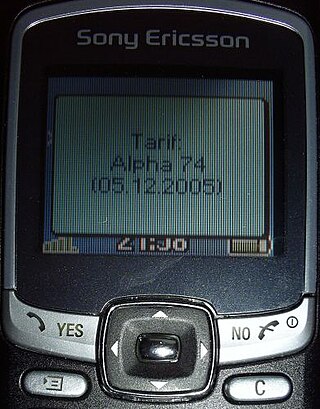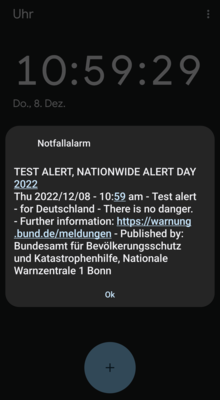
General Packet Radio Service (GPRS), also called 2.5G, is a packet orientated mobile data standard on the 2G cellular communication network's global system for mobile communications (GSM). GPRS was established by European Telecommunications Standards Institute (ETSI) in response to the earlier CDPD and i-mode packet-switched cellular technologies. It is now maintained by the 3rd Generation Partnership Project (3GPP).

Short Message/Messaging Service, commonly abbreviated as SMS, is a text messaging service component of most telephone, Internet and mobile device systems. It uses standardized communication protocols that let mobile devices exchange short text messages. An intermediary service can facilitate a text-to-voice conversion to be sent to landlines.
The Universal Mobile Telecommunications System (UMTS) is a third generation mobile cellular system for networks based on the GSM standard. Developed and maintained by the 3GPP, UMTS is a component of the International Telecommunication Union IMT-2000 standard set and compares with the CDMA2000 standard set for networks based on the competing cdmaOne technology. UMTS uses wideband code-division multiple access (W-CDMA) radio access technology to offer greater spectral efficiency and bandwidth to mobile network operators.
In telecommunication, a public land mobile network (PLMN) is a combination of wireless communication services offered by a specific operator in a specific country. A PLMN typically consists of several cellular technologies like GSM/2G, UMTS/3G, LTE/4G, NR/5G, offered by a single operator within a given country, often referred to as a cellular network.
The GPRS core network is the central part of the general packet radio service (GPRS) which allows 2G, 3G and WCDMA mobile networks to transmit Internet Protocol (IP) packets to external networks such as the Internet. The GPRS system is an integrated part of the GSM network switching subsystem.
Mobility management is one of the major functions of a GSM or a UMTS network that allows mobile phones to work. The aim of mobility management is to track where the subscribers are, allowing calls, SMS and other mobile phone services to be delivered to them.
Network switching subsystem (NSS) is the component of a GSM system that carries out call out and mobility management functions for mobile phones roaming on the network of base stations. It is owned and deployed by mobile phone operators and allows mobile devices to communicate with each other and telephones in the wider public switched telephone network (PSTN). The architecture contains specific features and functions which are needed because the phones are not fixed in one location.

Unstructured Supplementary Service Data (USSD), sometimes referred to as "quick codes" or "feature codes", is a communications protocol used by GSM cellular telephones to communicate with the mobile network operator's computers. USSD can be used for WAP browsing, prepaid callback service, mobile-money services, location-based content services, menu-based information services, and as part of configuring the phone on the network. The service does not require a messaging app, and does not incur charges.
The IP Multimedia Subsystem or IP Multimedia Core Network Subsystem (IMS) is a standardised architectural framework for delivering IP multimedia services. Historically, mobile phones have provided voice call services over a circuit-switched-style network, rather than strictly over an IP packet-switched network. Various voice over IP technologies are available on smartphones; IMS provides a standard protocol across vendors.

An emergency population warning is a method where by local, regional, or national authorities can contact members of the public to warn them of an impending emergency. These warnings may be necessary for a number of reasons, including:
Multimedia Broadcast Multicast Services (MBMS) is a point-to-multipoint interface specification for existing 3GPP cellular networks, which is designed to provide efficient delivery of broadcast and multicast services, both within a cell as well as within the core network. For broadcast transmission across multiple cells, it defines transmission via single-frequency network configurations. The specification is referred to as Evolved Multimedia Broadcast Multicast Services (eMBMS) when transmissions are delivered through an LTE network. eMBMS is also known as LTE Broadcast.
The Short Message Service is realised by the use of the Mobile Application Part (MAP) of the SS7 protocol, with Short Message protocol elements being transported across the network as fields within the MAP messages. These MAP messages may be transported using "traditional" TDM based signalling, or over IP using SIGTRAN and an appropriate adaptation layer.
System Architecture Evolution (SAE) is the core network architecture of mobile communications protocol group 3GPP's LTE wireless communication standard.
Radio resource location services (LCS) protocol (RRLP) applies to GSM and UMTS Cellular Networks. It is used to exchange messages between a handset and an SMLC in order to provide geolocation information; e.g., in the case of emergency calls. The protocol was developed in order to fulfil the Wireless Enhanced 911 requirements in the United States. However, since the protocol does not require any authentication, and can be used outside of a voice call or SMS transfer, its use is not restricted to emergency calls and can be used by law enforcement to pinpoint the exact geolocation of the target's mobile phone. RRLP was first specified in 3GPP TS 04.31 - Location Services (LCS); Mobile Station (MS) - Serving Mobile Location Centre (SMLC); Radio Resource LCS Protocol (RRLP).
In mobile telephony GSM 03.38 or 3GPP 23.038 is a character encoding used in GSM networks for SMS, CB and USSD. The 3GPP TS 23.038 standard defines GSM 7-bit default alphabet which is mandatory for GSM handsets and network elements, but the character set is suitable only for English and a number of Western-European languages. Languages such as Chinese, Korean or Japanese must be transferred using the 16-bit UCS-2 character encoding. A limited number of languages, like Portuguese, Spanish, Turkish and a number of languages used in India written with a Brahmic scripts may use 7-bit encoding with national language shift table defined in 3GPP 23.038. For binary messages, 8-bit encoding is used.

Wireless Emergency Alerts, is an alerting network in the United States designed to disseminate emergency alerts to mobile devices such as cell phones and pagers. Organizations are able to disseminate and coordinate emergency alerts and warning messages through WEA and other public systems by means of the Integrated Public Alert and Warning System.
Data Coding Scheme is a one-octet field in Short Messages (SM) and Cell Broadcast Messages (CB) which carries a basic information how the recipient handset should process the received message. The information includes:
Reverse 1-1-2 is a public safety communications technology used by public safety organizations throughout the world to communicate with groups of people in a defined geographic area. Reverse 1-1--2 allows authorities to rapidly warn those in danger, directly through their mobile phones.

EU-Alert is the generic term for the European Public Warning Service based upon Cell Broadcast technology.

Emergency Cell Broadcast System (ECBS) is an alert broadcast system in the Philippines, designed to disseminate emergency alerts and warnings to mobile devices via cell broadcast services (CBS)










